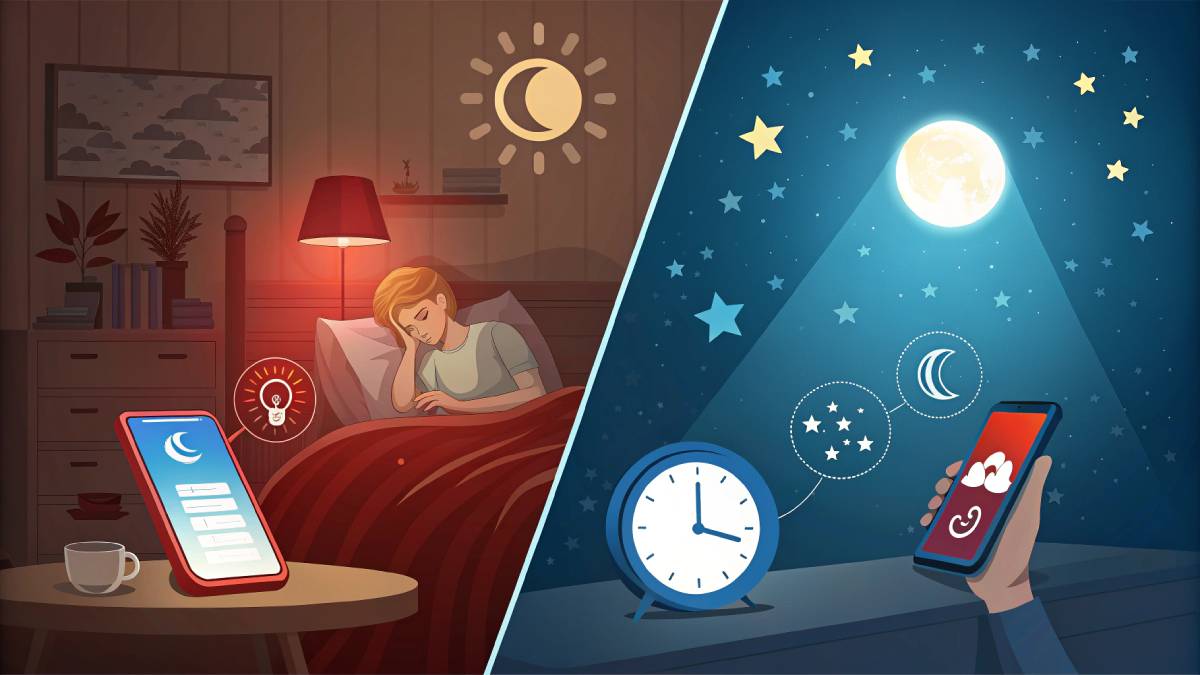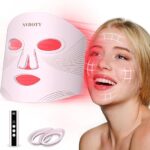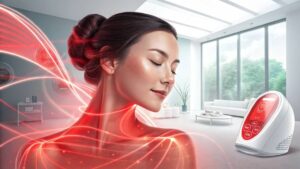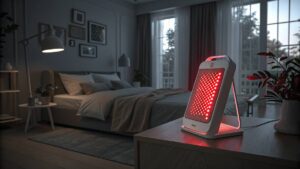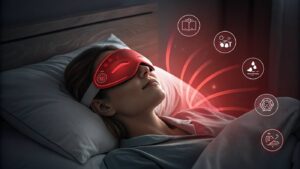Are you tired of tossing and turning each night? Imagine harnessing the power of light to unlock your best sleep ever. In our deep dive into red versus blue light, we reveal how choosing the right glow can revolutionize your sleep hygiene and overall health.
From blue light’s disruptive effects on melatonin production to red light’s soothing embrace that preserves your natural circadian rhythm, this article unpacks cutting-edge research and practical applications.
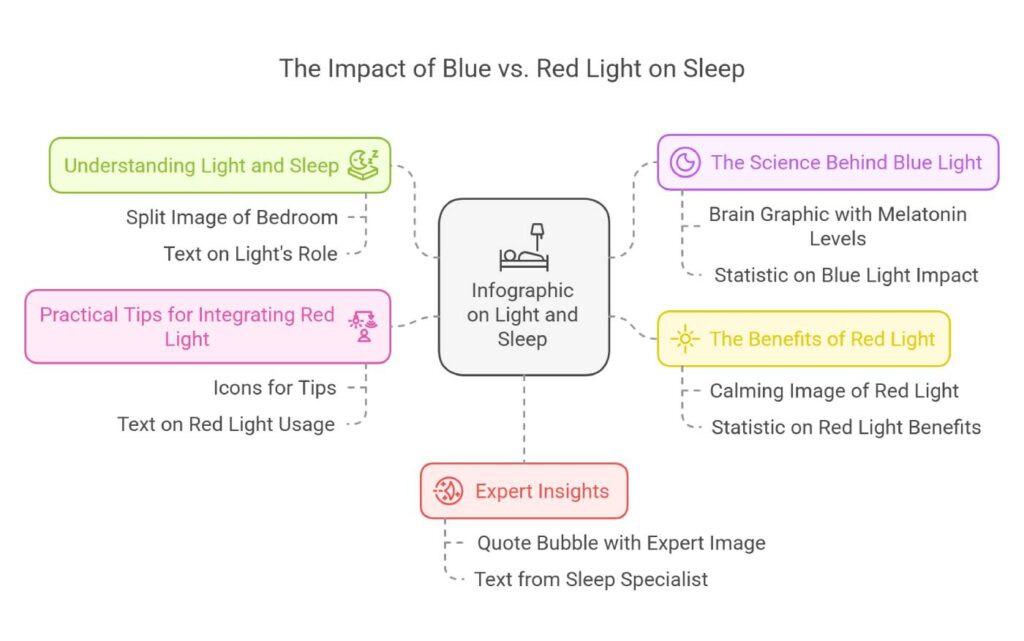
Get ready to transform your nightly routine with insights that blend science and simplicity, ensuring that every night turns into a rejuvenating journey toward a healthier, happier you.
Understanding Sleep and Light
Ah, sleep—the elusive friend we often take for granted. Who knew a simple flick of flipping the switch on the wrong type of light could keep you counting sheep until the break of day? But don’t worry; we’re here to shed some, ahem, light on the subject. We’re diving into the world of blue and red light to see how each plays its part in your nightly dance with Mr. Sandman. Let’s get comfy.
Impact of Blue Light on Sleep
Pretend for a moment you’re relaxing after a long day, scrolling through memes on your phone, and unknowingly basking in blue light from screens, LEDs, and neon office lights. While that cat video might be hilarious, the blue light isn’t doing your sleep any favors. It’s like coffee for your eyeballs, tricking your brain into thinking it’s still daytime (Sleep Foundation).
This type of light pokes your melatonin—your “time-to-sleep” hormone—making it run for the hills, leaving you staring at the ceiling. It messes with your body’s natural flow, raising your alertness right when you’d rather be snoring.
| Impact of Blue Light | Effects |
|---|---|
| Hormone Production | Melatonin goes on vacation |
| Sleep Cycle | Throws off your groove |
| Alertness | Cranks it up, just when you don’t need it |
For the insomniacs at heart, or if you’re just trying something less ambitious than giving up evening screen time, check out how Red Light might just be your new sleep-aid hero. Swing by our page on red light therapy melatonin.
Benefits of Red Light Therapy
Enter the red light, stage left. Unlike its energetic cousin, red light is like a warm hug for your sleep schedule. It tiptoes around your brain’s sleep-wake timer, leaving your precious melatonin alone (WebMD).
Red light proudly stands its ground when it comes to improving sleep without messing with your body’s rhythm (Healthline). Sunlight in the day, red light in the evening, and good old darkness at night—now that’s a combo your circadian rhythm can samba too.
| Red Light Benefits | Details |
|---|---|
| Circadian Rhythm | Remains intact |
| Melatonin Production | Left unharmed |
| Sleep Quality | Gets a boost |
Fancy weaving red light into your bedtime story? Peek at ideas like how to use red light therapy for sleep and red light therapy sleep routine.
In the end, understanding the roles of blue and red light in your sleep routine is like cracking a cheat code for better snoozing. Taming blue light exposure and inviting the soothing embrace of red light might just be your golden ticket to sweet dreams and brighter days.
Blue Light vs. Red Light Therapy
Ever wonder how the glow from your phone or that nifty red nightlight affects your slumber? It’s crucial, especially if you’re tossing and turning, trying to figure out why you can’t catch those Z’s. Understanding how blue and red light jive with your sleep routines could be your ticket to the Dreamland Express.
Blue Light Disruption
Blue light is a bit of a mixed bag. It’s great for keeping you alert and ready to roll when the sun’s up, but get cozy with it too close to bedtime, and it’s like inviting an unwanted guest to your snooze party. This pesky wavelength, pumped out by screens everywhere, fools your brain into thinking it’s still party time, thanks to its knack for suppressing melatonin—that sneaky hormone that lulls you into dreamland.
| What Happens? | How Blue Light Messes With You |
|---|---|
| Melatonin | Blocks the sleep-inducing hormone |
| Sleep Quality | Knocks your body clock out of whack |
| Health | Linked to mood swings, diet mishaps, and a cloudy mind |
To dodge the blue light blues, managing your screen time is key—check out our sleep hygiene tips for a crash course on cutting back.
Red Light Influence on Melatonin
Remember the calm that a red light can bring? Unlike its blue cousin, red light rolls out the red carpet for melatonin, helping you snooze soundly without crashing your body’s rhythm party (Healthline).
| Why Red Works | How Red Keeps Things Cozy |
|---|---|
| Melatonin | Helps the hormone do its sleepy magic |
| Sleep Quality | Keeps your snooze cycle smooth |
| Health | Boosts bedtime vibes, even for athletes looking to max out their recovery time |
So, if you’re thinking about giving red light a whirl, shine it bright in the morning, dim it down by evening, and keep it dark for lights out—explore more about it in our red light therapy melatonin guide.
Intrigued by what red light offers for sleep? Get the full lowdown and recommendations for red light therapy devices on our site.
Decoding the different vibes blue and red lights send to your sleepy brain can help you make smarter choices about lighting up your life. Tune into what suits you best, and let the rhythm of the night flow, bringing you peace and sweet dreams.
Red Light Therapy Benefits
Research on Red Light Therapy
Red light therapy (RLT) is making waves as a natural go-to for sleep and overall health. You might be wondering what’s behind its magic. Well, it turns out red light gets melatonin, the sleepy-time hormone, up and running. This helps keep those internal clocks ticking right, leading to better sleep cycles.
But that’s not all; red light’s glow also jazzes up your cells, promoting skin health, faster wound healing, soothed muscles, collagen rev-up, reduced achiness, and better blood flow. Thanks to a jolt of nitric oxide, circulation gets a boost, pain eases, and healing speeds up too.
Back in 2012, some hardworking researchers in China put RLT to the test on a group of female basketball players. The red light crew saw more melatonin and snoozed better than those who didn’t get the glow. They used a setup like a tanning bed but for health instead of a tan (CNN).
Red Light Therapy for Sleep Quality
If sleep’s been eluding you, red light therapy might just be the buddy you need. It’s a non-drug way to tackle sleep disorders and insomnia, helping balance those circadian rhythms for sleep that’s not just deep but uninterrupted (red light therapy circadian rhythm).
Check out the findings:
| Study | Participants | Findings |
|---|---|---|
| China-based (2012) | Female basketball players | Better sleep and higher melatonin |
| Peripheral Neuropathy Study | Folks with neuropathy | Better sensation and function with near-infrared and red light, three times a week for six weeks (HealthLight LLC) |
Older folks love red light therapy because it’s a sleep aid that doesn’t come in a pill bottle. When used regularly, it smooths out sleep habits and boosts the quality of’s. If you’re curious about getting started, don’t sweat it—check out our guide for some handy steps and tricks on how to use red light therapy for sleep.
There’s a range of gadgets to try, from full-body panels to sleep masks and mini handheld options, so you can find one that fits your groove. Dive into our list of the best red light therapy devices for sleep to see what catches your eye.
To wrap it up, red light therapy is like nature’s doze-off button. It props up melatonin, tunes up cellular doings, and keeps your internal clock ticking right. Queue up some cozy evenings with this natural sleep helper. For more details and pointers, peek at our guide on red light therapy for sleep.
Red Light Therapy Studies
Discovering ways to catch zzz’s and break free from morning grogginess is a dream come true for many. Turns out, red light therapy might be the sleepy-time superhero we’ve all been waiting for. Now, let’s take a look at what science says and dive into two snazzy studies that dabble in the snooze-inducing powers of red light therapy.
Female Athletes Study
Back in the day – yes, 2012 counts – Chinese researchers took on the task of testing red light therapy on female basketball players. Now, before you raise an eyebrow, imagine a tanning bed. Yeah, it’s kinda like that but with red light beaming away.
These researchers found that players dosing up on red light not only hit the hay better but also boosted their melatonin, the sleep hormone superstar.
| Group | Better Sleep Vibes | Melatonin Boost |
|---|---|---|
| Red Light Crew | Oh yeah! | You betcha! |
| Placebo Posse | Nope | Nada |
Curious to try it out yourself or do just want to know more? Check out our tips on actually using red light therapy to rock your sleep.
Sleep Inertia Improvement Study
Fast forward to 2019, Mariana Figueiro gave red light therapy another go with 30 adults, aiming to zap away that pesky sleep inertia – you know, that bleary feeling right after waking up. People donned the red light while snoozing and upon waking to test its powers. Spoiler alert – it worked! Folks felt perkier in the A.M. when red light therapy was their bedtime buddy.
| Folks | Bye-bye Inertia | Morning Mojo |
|---|---|---|
| Red Light Brigade | Heck yes! | Oh yeah! |
| Regular Joes | Nope | Nada |
These studies get straight to the point: Red light therapy could be the gentle nudge you need toward dreamland without popping pills. Interested in more deets? Scoop up insights on the perks of red light therapy for sleep and peep at the best red light gear out there.
Don’t stop now! If you’re geeked out on rhythms and how red light messes with them (in a good way), make sure to check out our piece on red light therapy’s role in your body clock.
Practical Applications of Red Light
Red Light for Sleep Hygiene
Red light therapy is becoming a handy friend for folks looking to skip the pills and level up their sleep game. WebMD says red light is the least disruptive to our body clocks, so using it in the evenings could be a game-changer. It’s all about swapping out that pesky blue light for soothing red to keep your body’s sleep schedule on track.
Want to try it out? Here’s how:
- Use red light gadgets before hitting the hay.
- Swap regular light bulbs with red-tinted ones in your bedroom.
- Carry portable red light devices if you’re on the move.
For more tips, check out our guide on how to use red light therapy for sleep.
| Strategy | Benefits |
|---|---|
| Red Light Therapy Devices | Boosts melatonin, cuts down sleep inertia |
| Red-Tinted Bulbs | Keeps your body clock ticking right |
| Portable Devices | Easy and handy use |
Red Light as a Nightlight
Red light therapy shines bright as a nightlight superhero too. Those regular nightlights? They throw off a blue or white light, messing with your sleep. But not red ones. They keep your sleepy hormones in check, giving just enough glow for nighttime tasks (PMC).
Think about using red nightlights in bedrooms and hallways to find your way around without waking yourself up too much. Want the best setups? Dive into our picks for the best red light therapy devices for sleep.
| Type of Nightlight | Effectiveness |
|---|---|
| Traditional Nightlights | Throws melatonin out of whack |
| Red Light Nightlights | Keeps sleep cycles steady |
Looking for more on how red lights can work wonders for your nighttime routine? Peek into our story on red light therapy sleep routine.
Wrapping it up, red light’s practical uses can really turn things around for your sleep hygiene and help nail down a steady sleep-wake cycle. Start using red light therapy every day and watch your sleep quality and health soar. Need more insights? Explore red light therapy circadian rhythm.
Red Light Therapy and Circadian Rhythms
Getting the hang of how light affects your sleep is like the cheat code to better snooze time. Enter red light therapy: your new go-to for syncing up those body rhythms to catch more z’s naturally and wake up feeling like a champ.
Red Light for Circadian Alignment
Red light is like the silent ninja of lights – helpful without wrecking your natural sleep pattern. Unlike other lights, it lets your body keep making melatonin – that magic sleep juice your body craves.
The big win with a red light? It’s all about boosting your REM sleep. That’s the deep, dreamy stuff you need for a sharp mind and stable emotions. Skip this part of sleep and you might feel grumpy, moody, or just off (Frontiers in Psychiatry).
Battling insomnia or staying awake longer than you’d like? Give red light therapy for sleep a shot. In a 2019 study, people who basked in red light at night and in the morning felt more awake and less groggy, ready to tackle the day.
Red Light vs. Blue Light on Rhythms
Blue light, mostly from your gadgets, is the worst buddy for sleep. It stops melatonin in its tracks, making it tough to drift off and stay in dreamland all night.
| Feature | Red Light | Blue Light |
|---|---|---|
| Melatonin Suppression | No | Yes |
| Circadian Disruption | Little | Lots |
| Sleep Quality Impact | Good vibes | Sleep Stealer |
Red light is your buddy in syncing sleep cycles without the nasty side effects of blue light. Give it a whirl as a nightlight to keep your sleep clean and rhythms in tune.
Wanna know more about bedtime red light setups? Our reads loads of tips on how to use red light therapy for sleep and the top red light therapy devices for sleep. Throw on some blue-blocker glasses to keep your melatonin flowing when artificial lights surround you.
Red light therapy – it’s like the peaceful warrior sleep needs, smoothing out your body clock glitches and dialing up that good-for-you rest. Snuggle up to sleep that’s both restful and restorative.
Expert Recommendations on Red Light
Red Light vs. No Light
When it comes down to picking between red light and no light for a good night’s sleep, the science swings in favor of the red glow. See, it’s all about how light messes with your internal body clock, known in science circles as the circadian rhythm.
Folks over at WebMD highlight this perfectly—red light has the uncanny ability of being the least disruptive to our natural rhythms. This makes the red light bulb a superstar choice for anyone looking to have some light without ruining their shut-eye.
It doesn’t dart melatonin out the window like other lights do, helping you keep your natural sleep cycle ticking smoothly.
Here’s a bootleg chart just for giggles, illustrating the sleep outcomes with different lighting scenarios:
| Lighting Condition | Impact on Melatonin | Effect on Sleep Quality |
|---|---|---|
| No Light | Optimal | Maximum |
| Red Light | Minimal Impact | High |
| Blue Light | Suppresses Melatonin | Low |
Red Light for Better Sleep
Red light might just be your sleep hygiene’s best buddy. By keeping your biological clock in harmony and letting melatonin do its job, you dodge the nightmare interruptions other lights bring. According to CNN, while red light doesn’t exactly sing you to sleep, it sure stops the loud ruckus bright or blue lights bring when trying to catch Z’s.
To cash in on the red light bonus, experts suggest these handy tips:
- Wind down with red light therapy devices for about half an hour before hitting the hay.
- Swap those blinding nightlights out for red light ones. Your eyeballs—and your sleep—will thank you.
- If you’re all about that deep REM sleep without waking up a hundred times, think about using red light regularly in your sleeping quarters. According to some brainy folks at Frontiers in Psychiatry, this could be just the ticket for better sleep quality and mood balancing.
Making red light part of your bedtime routine doesn’t just mean buying the right gadgets; it’s about using them consistently to let your body clock groove along naturally. Dive deeper into how red light therapy can help you snooze like a pro and scope out the best devices for your sleep sanctuary.
Conclusion
To wrap up, the battle between blue and red light reveals crucial insights into sleep health. Our analysis demonstrates that while blue light’s stimulating properties can disrupt melatonin production and interfere with your natural sleep cycle, red light therapy emerges as a powerful, non-invasive solution to promote restorative sleep.
By adopting red-tinted lighting solutions and integrating red light devices into your nighttime routine, you can protect your circadian rhythm, enhance sleep quality, and boost overall well-being.
The wealth of research—from controlled studies on athletes to practical applications in everyday sleep hygiene—underscores red light’s potential to transform your sleep experience. This innovative approach not only aids in achieving better rest but also contributes to improved mood, sharper mental clarity, and faster physical recovery.
Embrace this science-backed strategy to reclaim your nights and energize your days with uninterrupted, quality sleep that truly refreshes your body and mind.
FAQs
How does blue light affect sleep?
Blue light disrupts melatonin production, making it harder for your body to transition into sleep mode and disturbing your circadian rhythm.
What benefits does red light therapy offer?
Red light therapy supports melatonin production, preserves your natural sleep cycle, improves sleep quality, and enhances overall well-being.
Are there scientific studies supporting red light therapy?
Yes, various studies—ranging from research on athletes to controlled trials—highlight red light therapy’s effectiveness in reducing sleep inertia and promoting better sleep.
How can I incorporate red light into my routine?
You can use red-tinted bulbs, portable red light devices, or dedicated red light therapy panels in your bedroom to create a sleep-friendly environment.
Can red light therapy improve my overall health?
Improved sleep quality from red light therapy can lead to enhanced mood, better mental clarity, and improved physical recovery.
Main Tips
- Limit Evening Blue Light Exposure: Reduce screen time before bed or use blue light filters.
- Integrate Red Light: Replace harsh nightlights with red-tinted bulbs or portable red light devices.
- Establish a Consistent Routine: Maintain regular sleep hours to support your circadian rhythm.
- Stay Informed: Follow expert studies and reliable sources on sleep and light therapy.
- Invest in Quality Products: Choose scientifically validated red light therapy devices for the best results.
Recommended Products and Accessories
- Red Light Therapy Sleep Mask: A portable mask that emits red light to improve sleep quality.
- Portable Red Light Device: Compact, battery-operated devices for on-the-go red light therapy.
- Red-Tinted Nightlights: Replace standard nightlights with red-tinted options to maintain sleep-friendly lighting.
- Full-Body Red Light Panels: For those looking to invest in comprehensive red light therapy systems.
- Red Light Therapy Bulbs: Easy-to-install bulbs that provide a soothing red glow for any bedroom.
Final Thoughts
The research and practical insights provided clearly indicate that the quality of your sleep is significantly influenced by the type of light you expose yourself to. Embracing red light therapy can transform not only your nightly routine but also your overall well-being.
By minimizing blue light exposure and incorporating red-tinted solutions, you support your body’s natural melatonin production and circadian rhythm. Whether you’re battling chronic sleep issues or simply seeking to optimize your sleep hygiene, the science behind red light therapy offers a promising, non-invasive remedy.
Explore the practical tips, expert studies, and innovative products presented to design a sleep sanctuary that recharges your mind and body for each new day.

